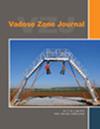Soil hydraulic property maps for the contiguous United States at 100‐m resolution and seven depths: Code design and preliminary results
IF 2.8
3区 地球科学
Q3 ENVIRONMENTAL SCIENCES
引用次数: 0
Abstract
Estimates of the van Genuchten (1980, abbreviated as VG) parameters and saturated hydraulic conductivity (美国毗连地区 100 米分辨率和七个深度的土壤水力特性图:代码设计和初步结果
通过将 Ramcharan 等人的 SoilGrids+ (SG+) 土壤属性图与 Zhang 等人的 Rosetta3 分级传导函数 (PTFs) 中的 R3H3 成员相结合,以 100 米的分辨率和七个土壤深度估算出了美国毗连地区的 van Genuchten(1980 年,缩写为 VG)参数和饱和导流系数 (Ks)。为此,我们开发了多线程代码,可根据并行程度显著提高计算速度(最高可达 25 倍)。首先,我们计算了国家合作土壤调查(NCSS)(2023 年)实验室样本数据库中 14113 个血统的 SG+基本属性估算值与实际测量土壤属性的简单汇总统计数据,从而验证了估算值。接着,我们对 NCSS 和 SG+ 数据计算了 PTF 估算含水量的汇总统计。结果表明,估计误差主要由 PTF 的固有误差造成,而 SG+ 土壤特性和 PTF 估计值中存在(可能纠正的)系统误差。所绘制的水力特性图包含 7.5 亿多个点,分布在七个土层中的每一层,并显示出每个 VG 参数和 Ks 在水平方向和深度方向上的巨大差异,但 VG "n "参数除外,其值主要在 1.25 和 1.6 之间。水力特性图的完整度高达 99.9%,我们证明几乎每个点都可以生成可信的剖面图和不确定性信息。每个 SG+ 图层有两张多通道 GeoTIFF 地图:一张包含五个水力参数,另一张包含相应的协方差。
本文章由计算机程序翻译,如有差异,请以英文原文为准。
求助全文
约1分钟内获得全文
求助全文
来源期刊

Vadose Zone Journal
环境科学-环境科学
CiteScore
5.60
自引率
7.10%
发文量
61
审稿时长
3.8 months
期刊介绍:
Vadose Zone Journal is a unique publication outlet for interdisciplinary research and assessment of the vadose zone, the portion of the Critical Zone that comprises the Earth’s critical living surface down to groundwater. It is a peer-reviewed, international journal publishing reviews, original research, and special sections across a wide range of disciplines. Vadose Zone Journal reports fundamental and applied research from disciplinary and multidisciplinary investigations, including assessment and policy analyses, of the mostly unsaturated zone between the soil surface and the groundwater table. The goal is to disseminate information to facilitate science-based decision-making and sustainable management of the vadose zone. Examples of topic areas suitable for VZJ are variably saturated fluid flow, heat and solute transport in granular and fractured media, flow processes in the capillary fringe at or near the water table, water table management, regional and global climate change impacts on the vadose zone, carbon sequestration, design and performance of waste disposal facilities, long-term stewardship of contaminated sites in the vadose zone, biogeochemical transformation processes, microbial processes in shallow and deep formations, bioremediation, and the fate and transport of radionuclides, inorganic and organic chemicals, colloids, viruses, and microorganisms. Articles in VZJ also address yet-to-be-resolved issues, such as how to quantify heterogeneity of subsurface processes and properties, and how to couple physical, chemical, and biological processes across a range of spatial scales from the molecular to the global.
 求助内容:
求助内容: 应助结果提醒方式:
应助结果提醒方式:


